
We are celebrating 15 years — and counting — of stories that are deeply researched and deeply felt, that build a historical record of what the city has been.
We are celebrating 15 years — and counting — of stories that are deeply researched and deeply felt, that build a historical record of what the city has been.
A project of The Noguchi Museum and Socrates Sculpture Park
The text below is excerpted from project statements by each participating team.
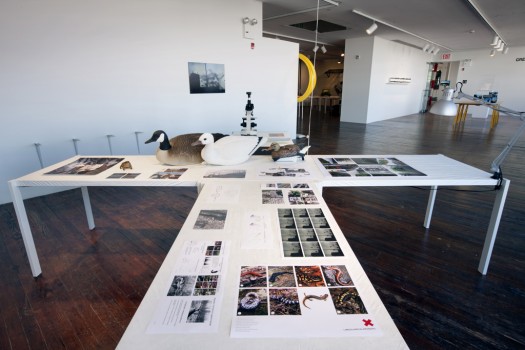
UP 2 U installation by artist Natalie Jeremijenko and project team as part of Civic Action: A Vision for Long Island City | Photo by Bill Taylor, Courtesy of The Noguchi Museum
UP 2 U
Natalie Jeremijenko, Nina Rappaport, Alex Felson, Edward Peck, Fran Gallardo, David Fletcher, Usman Haque, Angel Borego, PWP Landscape Architecture
In UP_2_U, the systems for energy, food, manufacturing, distribution, and mobility in Long Island City are creatively, but ever so practically adapted to actually improve environmental and human health and explore a tasty biodiverse future. It is around this common good of shared environmental health that participation is structure, adapted and scaled to a new (organism-centric) urbanism of BiodiverCITY, ComplexCITY and SynchroniCITY.
This is a smart Long Island City that seizes the opportunity that real-time “smart-city” technology provides to close feedback loops and radically improve environmental health. What would Long Island City be if the trees owned themselves and the land they inhabit; if salamanders traveled on superhighways and tweeted us when they migrate? How much would we improve air quality if we used flylines to connect the manufacturers to the distribution port instead of, for instance, 76 asthma-causing diesel trucks that pick up bread every morning from each of the 15 or so commercial bakeries in the area?
Think Charlie and the Chocolate Factory × Steve Irwin × engineering 4 people × Doctors Without Borders, only it is your own city’s backyard populated with exhilarating devices, marvelous couplings, delicious new foods and spectacles that are designed to create shared public memories of very possible futures.
— Excerpted from the team’s project statement by Natalie Jeremijenko and Nina Rappaport
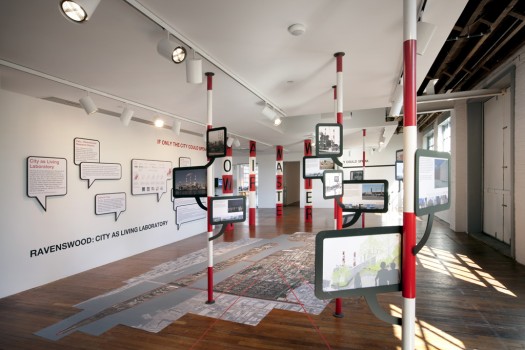
R/Call: IF ONLY THE CITY COULD SPEAK installation by artist Mary Miss and project team as part of Civic Action: A Vision for Long Island City | Photo by Bill Taylor, Courtesy of The Noguchi Museum
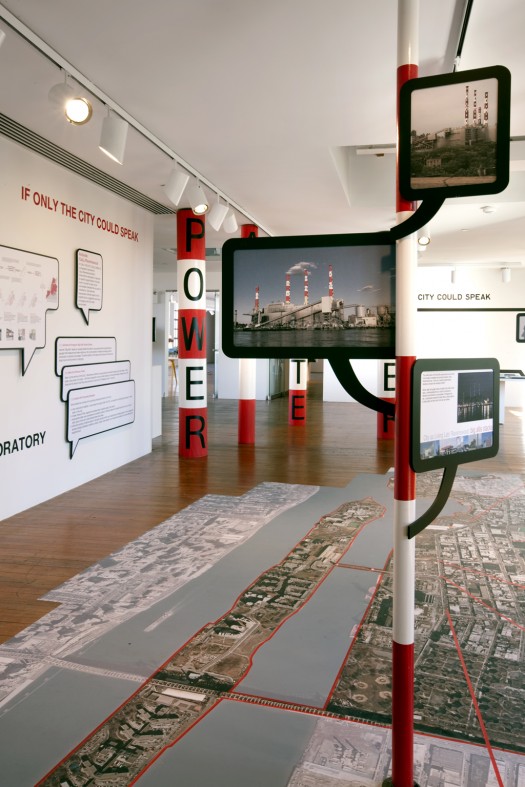
R/Call: IF ONLY THE CITY COULD SPEAK installation by artist Mary Miss and project team as part of Civic Action: A Vision for Long Island City | Photo by Bill Taylor, Courtesy of The Noguchi Museum
R/Call: IF ONLY THE CITY COULD SPEAK
Mary Miss, Elliott Maltby, Belinda Kanpetch, Robert Sullivan
The city is a perpetual experiment that is — in the case of New York — poised on an estuary of tidal creeks and old streams, on suburb-born rivers that still make themselves known in one way or another. Ideas and technologies rise and fall and intermingle, like waters in the harbor, and neighborhoods and ways of living are scrapped or redefined or invented anew, as masses of people move in and out, are both and die — all adjustments of the civic equilibrium for better or worse or both. Improvements catch on slowly or sometimes disappear, through no fault of their own.
But what if one section of the city worked like a small plot on a big farm? What if one district were recognized not just for its historic nature or its subway access or its view but as a planned site of inventiveness? What if one neighborhood were a place where the creativity that marks city life was championed?
It would be an innovation district, where engineers and scientists, artists and urbanists of all stripes were invited to explore alternatives to the city’s current systems, to speculate with its streets, its buildings, its infrastructure — to reexamine the way we think of the city itself. For artists to have the opportunity, for example, to repurpose the exterior of an electrical plant, to show life becoming more sustainable, with all the economic and public health considerations that sustainability entails. It would be a place where artists went beyond filling up spaces with studios — where artists’ projects would reimagine what an urban neighborhood might be, and, thus, drive change other than gentrification.
— Excerpted from the team’s project statement by Robert Sullivan
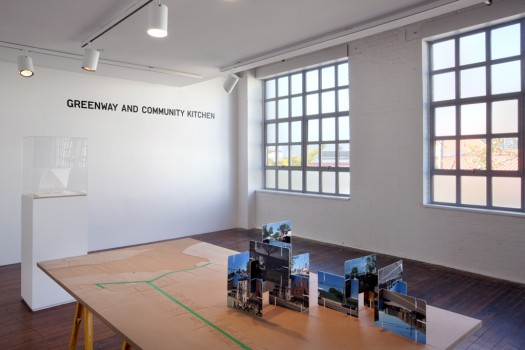
Greenway and Community Kitchen installation by artist Rirkrit Tiravanija and project team as part of Civic Action: A Vision for Long Island City | Photo by Bill Taylor, Courtesy of The Noguchi Museum
GreenWay and Community Kitchen
Rirkrit Tiravanija, Solveig Fernlund, Neil Logan
This project might be summarized as a tale of two tables but it might equally be said that we have chosen to work on the street. We propose to re-pave Broadway in Queens with drivable grass, which will turn it into a GreenWay running straight from the N/Q subway station to Socrates Sculpture Park. Any portion of the GreenWay can be closed off for special events, markets, movie screenings, dance parties or anything else that fits. At the end of the street there will be a temporary, and infinitely reusable, Community Kitchen containing a cooking area and a place to eat. The design unfolds a table lamp model (YA2) by Isamu Noguchi and gives it a super-table scale.
The two tables [in the exhibition] only point to a beginning. New techniques of street-sweeping and plowing will be invented. The GreenWay will require gentle techniques of addition, like fertilization and watering. These will produce a condition of ever-increasing complexity, of overgrowth and undergrowth. Spores will arrive and new plants will grow of their own accord. Perhaps they will be edible. More will be best.
— Excerpted from the team’s project statement by Molly Nesbit
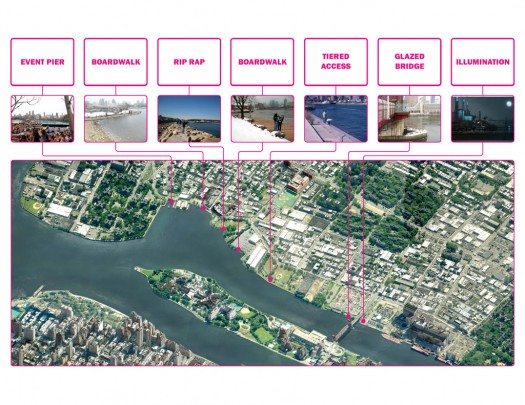
Map showing event pier, boardwalk, riprap, tiered access, glazed bridge and illumination | George Trakas | Courtesy the artist
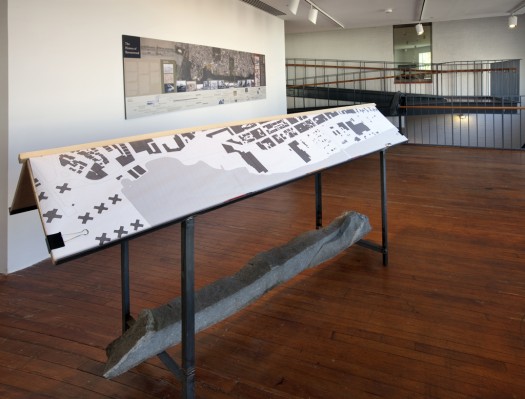
River Shoreline Walk installation by artist George Trakas and project team as part of Civic Action: A Vision for Long Island City | Photo by Bill Taylor, Courtesy of The Noguchi Museum
Shoreline Walk
George Trakas, Lyn Rice, Astrid Lipka, Amelia Black, Kathryn Henderson
In an effort to bring the community to the water’s edge, we seek to engage and encourage a dialogue with the property owners to unite the shoreline along the length of Ravenswood — taking a cue from the civic-minded actions of local figures like Isamu Noguchi and Mark di Suvero.
Reflecting on this legacy, we envision this neighborhood’s waterfront as an asset not just for the wealthy homes and booming economy that once called it home but also for the people who live here now. Guided by the disheveled remnants of boardwalk and bulkheads visible at low tide, a pleasing public space could be created by shoring up this riprap with large slabs of granite pinned and interlinked for longevity. We proposed that the water’s edge be reunified into a publicly accessible expanse. A shore walk would bring attention to the variety of natural and manmade structures that once existed and to the beauty of the place.
— Excerpted from the team’s project statement by Amelia Black
The views expressed here are those of the authors only and do not reflect the position of The Architectural League of New York.